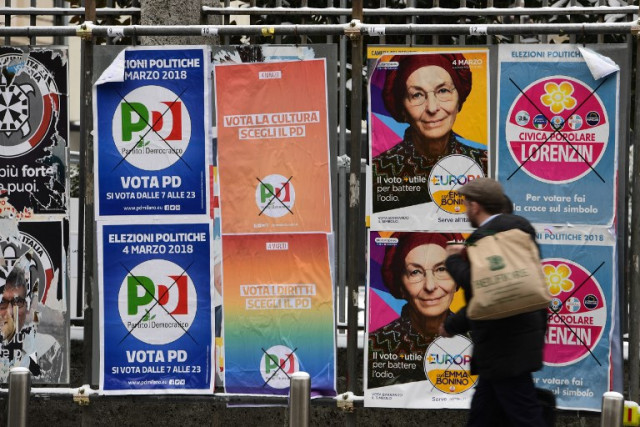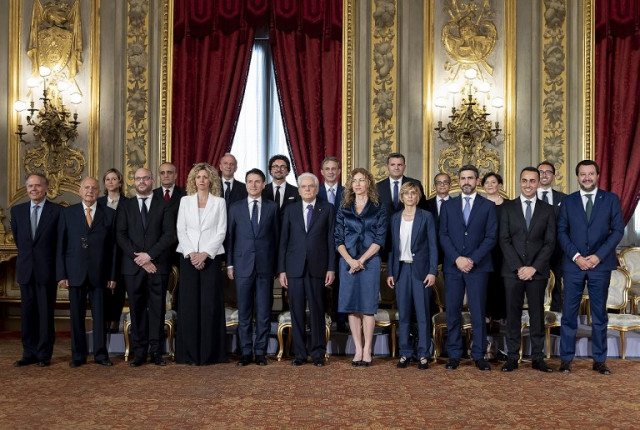TIMELINE: 15 months of drama in Italian politics

Giuseppe Conte was on Thursday given a new mandate to govern, this time with a coalition between the anti-establishment Five Star Movement and centre-left Democratic Party after the fall of the Five Star's alliance with the far-right League. So how did we get here? Here's a recap.
Inconclusive election
Italians vote on March 4th, 2018, in an uncertain election marked by a far-right and populist surge and a campaign dominated by anger against immigration. The outcome shakes the order of Italian politics that has been in place for half a century.
The anti-immigrant League party, led by Matteo Salvini, heads a right-wing coalition, which includes former prime minister Silvio Berlusconi's Forza Italia. The coalition overall takes 37 percent of the vote, with the League alone on 17 percent.
Meanwhile the anti-establishment Five Star Movement (M5S), led by Luigi Di Maio, becomes the leading single party with nearly 33 percent. Both the League and M5S claim they have won the mandate to govern.
READ MORE:
-
17 memorable quotes from Italy's rollercoaster election campaign
-
AS IT HAPPENED: The Local's live blog of the March 2018 election

Photo: Miguel Medina/AFP
Talks for a coalition
Forming a coalition government proves complicated and all early attempts come to nothing. In a major step forward the two parties publish on May 18th a joint policy programme for their would-be populist coalition -- anti-austerity, tough on immigration and security but no push to exit the euro.
On May 21st they propose a prime minister, little-known lawyer Giuseppe Conte, who gets working on drawing up a government.Italy's President Sergio Mattarella initially hesitates over the choice but after 48 hours names him as the new Italian premier.
However, the president rejects Conte's pick of staunch eurosceptic Paolo Savona as economy minister and Conte quits on May 27th.
On May 28th Mattarella appoints pro-austerity economist Carlo Cottarelli as prime minister, giving him the mandate to form a potential technocrat government and sparking fury from the League and M5S.
The parties launch a last-ditch bid to revive their coalition on May 31st, offering a compromise candidate in place of Savona, who is proposed as European Affairs minister.
READ MORE:
-
Here's how Italy's president explains his controversial veto
-
Here are the key proposals from the M5S-League government programme
Multiple conflicts
The government is officially formed on June 1st. Di Maio and Salvini are joint deputy prime ministers. It is the first time a purely populist administration holds power in a founding member of the European Union.
But very quickly Salvini, who is also interior minister, raises his profile, taking up airtime, column inches and social media clicks with his anti-immigrant diatribes, stirring up insecurity and eurosceptism.
Di Maio, who is also minister of economic development, labour and social policies, tries to regain the upper hand, lashing out at the EU over migrants and threatening to cut Rome's funding for the bloc. The clash leads to several conflicts at the heart of the coalition, raising doubts over the longevity of the populist government.
READ MORE:

Photo: Italian Presidency Press Office/AFP
European elections
In a historic success for the far-right, Salvini's League party wins the most votes in the May 2019 European elections in Italy with 34 percent.
On June 3rd Conte says he is ready to resign unless the two parties in the coalition stop squabbling.
Coalition cracks
On August 7th at a parliamentary vote, M5S votes against the financing of a multi-billion-euro high-speed train line between Lyon and Turin. The next day Salvini steps up the pressure, pulling his support for the coalition and calling for snap elections as soon as possible.
The abandoned M5S finds an unexpected ally in the opposition Democratic Party (PD) and former centre-left premier Matteo Renzi, now PD senator.
Renzi offers the M5S support for a pragmatic coalition that would pass the parliamentary reform and next year's budget to avoid an automatic rise in value-added tax.
Conte resigns
On August 20th Conte resigns, lashing out at Salvini for pursuing his own interests by pulling the plug on the coalition.
On August 22nd, President Sergio Mattarella sets a deadline for the squabbling parties to form a workable coalition government, failing which snap elections will be held.
New coalition accord
On August 28th, the M5S and PD, once bitter foes, agree to govern in a coalition under Conte. The next day President Mattarella gives Conte a mandate to form a new government.
PROFILE: Italy's PM Conte, the 'Mr Nobody' who found his voice
Comments
See Also
Inconclusive election
Italians vote on March 4th, 2018, in an uncertain election marked by a far-right and populist surge and a campaign dominated by anger against immigration. The outcome shakes the order of Italian politics that has been in place for half a century.
The anti-immigrant League party, led by Matteo Salvini, heads a right-wing coalition, which includes former prime minister Silvio Berlusconi's Forza Italia. The coalition overall takes 37 percent of the vote, with the League alone on 17 percent.
Meanwhile the anti-establishment Five Star Movement (M5S), led by Luigi Di Maio, becomes the leading single party with nearly 33 percent. Both the League and M5S claim they have won the mandate to govern.
READ MORE:
- 17 memorable quotes from Italy's rollercoaster election campaign
- AS IT HAPPENED: The Local's live blog of the March 2018 election

Photo: Miguel Medina/AFP
Talks for a coalition
Forming a coalition government proves complicated and all early attempts come to nothing. In a major step forward the two parties publish on May 18th a joint policy programme for their would-be populist coalition -- anti-austerity, tough on immigration and security but no push to exit the euro.
On May 21st they propose a prime minister, little-known lawyer Giuseppe Conte, who gets working on drawing up a government.Italy's President Sergio Mattarella initially hesitates over the choice but after 48 hours names him as the new Italian premier.
However, the president rejects Conte's pick of staunch eurosceptic Paolo Savona as economy minister and Conte quits on May 27th.
On May 28th Mattarella appoints pro-austerity economist Carlo Cottarelli as prime minister, giving him the mandate to form a potential technocrat government and sparking fury from the League and M5S.
The parties launch a last-ditch bid to revive their coalition on May 31st, offering a compromise candidate in place of Savona, who is proposed as European Affairs minister.
READ MORE:
- Here's how Italy's president explains his controversial veto
- Here are the key proposals from the M5S-League government programme
Multiple conflicts
The government is officially formed on June 1st. Di Maio and Salvini are joint deputy prime ministers. It is the first time a purely populist administration holds power in a founding member of the European Union.
But very quickly Salvini, who is also interior minister, raises his profile, taking up airtime, column inches and social media clicks with his anti-immigrant diatribes, stirring up insecurity and eurosceptism.
Di Maio, who is also minister of economic development, labour and social policies, tries to regain the upper hand, lashing out at the EU over migrants and threatening to cut Rome's funding for the bloc. The clash leads to several conflicts at the heart of the coalition, raising doubts over the longevity of the populist government.
READ MORE:

Photo: Italian Presidency Press Office/AFP
European elections
In a historic success for the far-right, Salvini's League party wins the most votes in the May 2019 European elections in Italy with 34 percent.
On June 3rd Conte says he is ready to resign unless the two parties in the coalition stop squabbling.
Coalition cracks
On August 7th at a parliamentary vote, M5S votes against the financing of a multi-billion-euro high-speed train line between Lyon and Turin. The next day Salvini steps up the pressure, pulling his support for the coalition and calling for snap elections as soon as possible.
The abandoned M5S finds an unexpected ally in the opposition Democratic Party (PD) and former centre-left premier Matteo Renzi, now PD senator.
Renzi offers the M5S support for a pragmatic coalition that would pass the parliamentary reform and next year's budget to avoid an automatic rise in value-added tax.
Conte resigns
On August 20th Conte resigns, lashing out at Salvini for pursuing his own interests by pulling the plug on the coalition.
On August 22nd, President Sergio Mattarella sets a deadline for the squabbling parties to form a workable coalition government, failing which snap elections will be held.
New coalition accord
On August 28th, the M5S and PD, once bitter foes, agree to govern in a coalition under Conte. The next day President Mattarella gives Conte a mandate to form a new government.
PROFILE: Italy's PM Conte, the 'Mr Nobody' who found his voice
Join the conversation in our comments section below. Share your own views and experience and if you have a question or suggestion for our journalists then email us at [email protected].
Please keep comments civil, constructive and on topic – and make sure to read our terms of use before getting involved.
Please log in here to leave a comment.